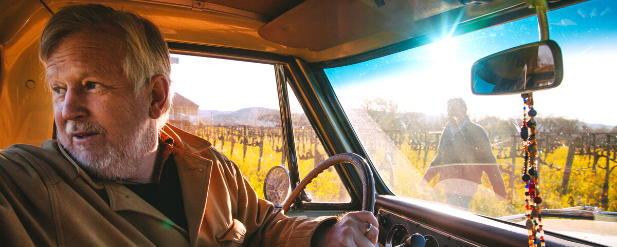
A few older bottles of Frog’s Leap…
16 February 2022
Julian Campbell
The biggest misconception about Frog’s Leap is that they’re often assumed to be a large-scale commercial operation. The truth is this is a family-owned winery producing just 45,000 cases per year across five cuvees. Far from looking to grow relentlessly, they are trimming production while simultaneously increasing their holdings of estate owned vineyards. John was one of the first people in the valley to adopt an organic approach in the vineyards and has been a great advocate for dry farming. And they are also great innovators in the winery. When it comes to thinking up new ways to produce ever more restrained, elegant wines, there no is no slavish devotion to oak barrels here…
As such, concrete plays a part in over half the wines. Entire rooms have been lined in thick concrete to hold their deliciously salty nutty Chardonnay sur lie for 12 months while much of their Zinfandel is aged in specially commissioned 1000 lt concrete cubes – a stackable size and shape that allows their Zinfandel blend to breathe without masking any of its deliciously fruity components.
And not content with producing some of the region’s most uplifting wines, they also have a hugely refreshing approach to the concept of growth and sustainability – both of the land but also for their people.
Another misconception is that because the wines are so fairly priced, they are only made for early consumption. And yet nothing could be further from the truth. At a recent lunch at the truly excellent Clarke’s in Notting Hill, John and Tori poured a selection of older vintages that proved without a doubt that these wines age with grace. We kicked off with a Zinfandel 1986, only the second Frog’s leap bottling of this variety. John quipped that, “we had no concept of this wine being drunk in thirty years back then– we were just messing around!” – and yet approaching 40 years later this ‘simple’ Zinfandel was still in remarkable shape. Flighty and floral yet unmistakably mature too, it glides across the palate revealing shiitake mushrooms and umeboshi plum, sour cherry and a touch of balsamic, coffee bean, mint sage and blood orange. A real shapeshifter, and still great fun to drink.
A 1992 Merlot followed, and it was a beauty. “We really shouldn’t make Merlot” John explained. “it’s hard to produce, hard to grow, has such high vigour that it has a tendency to go green, demands new oak, only grows well in clay soils, of which there are very few pockets in Rutherford, and above all else, no one wants it!”. Well, we want it, especially when it’s like this. Complex and grown up, this was a wine of remarkable precision with deep pure fruit, a touch of herbal freshness and effortlessly silky tannins.
Two estate Cabernet’s finished the line-up – a 2008 and a 1995. The 2008 was the more demure of the two, even a touch reserved at first – as is the presence of the older bottles made it feel a little shy. With air though, out came notes wild strawberry, dark berries, balsamic, wildflowers, stones… delicate and subtle, it grew into something refined and noble, a great example of poised Rutherford Cabernet, just entering phase two of its development. The finale came in the form of a 1995 Cabernet Sauvignon, and it was in glorious shape. Fresh and complex aromas of mint and sage over ripe dark fruit, iron rich sweet soil notes, fine dark chocolate, soy, balsamic and ripe dark plums – it was mature yet majestic, structured and sumptuous. A great advert for Rutherford Cabernet and evidence if it were needed of their ageing ability.


